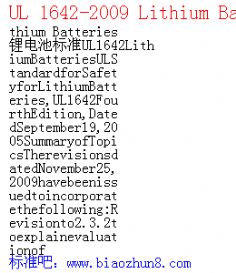UL 1642-2009 Lithium Batteries

UL 1642-2009 Lithium Batteries锂电池标准
UL1642
LithiumBatteriesULStandardforSafetyforLithiumBatteries,UL1642
FourthEdition,DatedSeptember19,2005
SummaryofTopics
TherevisionsdatedNovember25,2009havebeenissuedtoincorporatethefollowing:
Revisionto2.3.2toexplainevaluationofcomponentsusedinsideacellorbattery.
Revisiontothedefinitionof ″FullyDischarged″ andadditionofthedefinitionfor
″CompletelyDischarged″ totheGlossary.
Removalofredundanttestsin5.1.1;additiontestsin5.1.2and5.1.3;andclarificationof
″UserReplaceable″ in5.2.1.
SimplifyPerformanceTestingofacellbyrevising6.1.6.2andTables6.3and6.4;
deletingTables6.1and6.2.
Revised8.2toensuremonitoringoftemperaturesduringtheAbnormalChargingTest.
ClarificationoftheShortCircuitTestin10.1,10.4,and10.5.
ClarificationoftheAbnormalChargingTestin11.3;revisedprotectorcriteriain11.4,and
11.9.
Revisionsto12.2and12.3toalignwithchangestoGlossarydefinitions;Clarificationof
UltimateResultsCriteriain12.4;revisionstorevisedprotectorcriteriain12.5.
RevisionstotheCrushTestin13.1.
ConversiontoSIunitsin14.1-14.3;andinclusionoftolerancesin14.1.
Revised17.1toshowcorrectionofunitsandadditionalcriteriafortheHeatingTestfor
additionalbatterychemistries.
AdditionofSection22forPrimaryBatteryMarkings.
TextthathasbeenchangedinanymannerorimpactedbyUL’selectronicpublishingsystemismarked
withaverticallineinthemargin.Changesinrequirementsaremarkedwithaverticallineinthemargin
andarefollowedbyaneffectivedatenoteindicatingthedateofpublicationorthedateonwhichthe
changedrequirementbecomeseffective.
TherevisedrequirementsaresubstantiallyinaccordancewithProposal(s)onthissubjectdated
November3,2008andJune10,2009.
Allrightsreserved.Nopartofthispublicationmaybereproduced,storedinaretrievalsystem,or
transmittedinanyformbyanymeans,electronic,mechanicalphotocopying,recording,orotherwise
withoutpriorpermissionofUL.
ULprovidesthisStandard ″asis″ withoutwarrantyofanykind,eitherexpressedorimplied,includingbut
notlimitedto,theimpliedwarrantiesofmerchantabilityorfitnessforanypurpose.
NOVEMBER25,2009−UL1642 tr1www.bzfxw.com
InnoeventwillULbeliableforanyspecial,incidental,consequential,indirectorsimilardamages,
includinglossofprofits,lostsavings,lossofdata,oranyotherdamagesarisingoutoftheuseoforthe
inabilitytousethisStandard,evenifULoranauthorizedULrepresentativehasbeenadvisedofthe
possibilityofsuchdamage.InnoeventshallUL’sliabilityforanydamageeverexceedthepricepaidfor
thisStandard,regardlessoftheformoftheclaim.
UsersoftheelectronicversionsofUL’sStandardsforSafetyagreetodefend,indemnify,andholdUL
harmlessfromandagainstanyloss,expense,liability,damage,claim,orjudgment(includingreasonable
attorney’sfees)resultingfromanyerrorordeviationintroducedwhilepurchaserisstoringanelectronic
Standardonthepurchaser’scomputersystem.
TherequirementsinthisStandardarenowineffect,exceptforthoseparagraphs,sections,tables,figures,
and/orotherelementsoftheStandardhavingfutureeffectivedatesasindicatedinthenotefollowingthe
affecteditem.Thepriortextforrequirementsthathavebeenrevisedandthathaveafutureeffectivedate
arelocatedaftertheStandard,andareprecededbya ″SUPERSEDEDREQUIREMENTS″ notice.
NOVEMBER25,2009−UL1642 tr2SEPTEMBER19,2005
(TitlePageReprinted:November25,2009)
1
UL1642
StandardforLithiumBatteries
FirstEdition–October,1985
SecondEdition–November,1992
ThirdEdition–April,1995
FourthEdition
September19,2005
CommentsorproposalsforrevisionsonanypartoftheStandardmaybe
submittedtoULatanytime.ProposalsshouldbesubmittedviaaProposal
RequestinUL’sOn-LineCollaborativeStandardsDevelopmentSystem(CSDS)
athttp://csds.ul.com.
UL’sStandardsforSafetyarecopyrightedbyUL.Neitheraprintednorelectronic
copyofaStandardshouldbealteredinanyway.AllofUL’sStandardsandall
copyrights,ownerships,andrightsregardingthoseStandardsshallremainthe
soleandexclusivepropertyofUL.
COPYRIGHT©2009UNDERWRITERSLABORATORIESINC.www.bzfxw.com
NOVEMBER25,2009 LITHIUMBATTERIES-UL1642 2
NoTextonThisPageCONTENTS
INTRODUCTION
1Scope ...............................................................................5
2General ..............................................................................5
2.1Unitsofmeasurement ...........................................................5
2.2Terminology ...................................................................6
2.3Components ...................................................................6
3Glossary ............................................................................6
CONSTRUCTION
4General ..............................................................................7
4.1Casing ........................................................................7
4.2Electrolyte .....................................................................7
4.3Use...........................................................................8
PERFORMANCE
5General ..............................................................................8
5.1Technician-replaceablebatteries .................................................8
5.2User-replaceablebatteries .......................................................9
5.3Multicellinstallations ............................................................9
6Samples .............................................................................9
7ConditioningofSamples ..............................................................11
7.1Discharge ....................................................................11
7.2Charge-dischargecycling ......................................................11
8ImportantTestConsiderations .........................................................12
9TemperatureMeasurements ..........................................................12
TESTSFORTECHNICIAN-REPLACEABLEANDUSER-REPLACEABLEBATTERIES
ELECTRICALTESTS
10Short-CircuitTest ...................................................................12
11AbnormalChargingTest ............................................................13
12Forced-DischargeTest ..............................................................14
MECHANICALTESTS
13CrushTest .........................................................................15
14ImpactTest ........................................................................15
15ShockTest .........................................................................17
16VibrationTest ......................................................................17
ENVIRONMENTALTESTS
17HeatingTest .......................................................................17
18TemperatureCyclingTest ...........................................................18
19LowPressure(AltitudeSimulation)Test ...............................................18
NOVEMBER25,2009LITHIUMBATTERIES-UL16423www.bzfxw.com
FIREEXPOSURETEST
20ProjectileTest ......................................................................18
MARKING
21General ............................................................................19
22PrimaryBatteries ...................................................................20
APPENDIXA
StandardsforComponents..............................................................A1
NOVEMBER25,2009 LITHIUMBATTERIES-UL1642 4INTRODUCTION
1Scope
1.1Theserequirementscoverprimary(nonrechargeable)andsecondary(rechargeable)lithiumbatteries
foruseaspowersourcesinproducts.Thesebatteriescontainmetalliclithium,oralithiumalloy,ora
lithiumion,andmayconsistofasingleelectrochemicalcellortwoormorecellsconnectedinseries,
parallel,orboth,thatconvertchemicalenergyintoelectricalenergybyanirreversibleorreversible
chemicalreaction.
1.2Theserequirementscoverlithiumbatteriesintendedforuseintechnician-replaceableor
user-replaceableapplications.
1.3Theserequirementsareintendedtoreducetheriskoffireorexplosionwhenlithiumbatteriesare
usedinaproduct.Thefinalacceptabilityofthesebatteriesisdependentontheiruseinacomplete
productthatcomplieswiththerequirementsapplicabletosuchproduct.
1.4Theserequirementsarealsointendedtoreducetheriskofinjurytopersonsduetofireorexplosion
whenuser-replaceablelithiumbatteriesareremovedfromaproductanddiscarded.
1.5Theserequirementscovertechnician-replaceablelithiumbatteriesthatcontain5.0g(0.18ounce)or
lessofmetalliclithium.Abatterycontainingmorethan5.0goflithiumisjudgedonthebasisofcompliance
withtherequirementsinthisstandard,insofarastheyareapplicable,andfurtherexaminationandtestto
determinewhetherthebatteryisacceptableforitsintendeduses.
1.6Theserequirementscoveruser-replaceablelithiumbatteriesthatcontain4.0g(0.13ounce)orlessof
metalliclithiumwithnotmorethan1.0g(0.04ounce)ofmetalliclithiumineachelectrochemicalcell.A
batterycontainingmorethan4.0goracellcontainingmorethan1.0glithiummayrequirefurther
examinationandtesttodeterminewhetherthecellsorbatteriesareacceptablefortheirintendeduses.
1.7Theserequirementsdonotcoverthetoxicityriskthatmayresultfromtheingestionofalithiumbattery
oritscontents,northeriskofinjurytopersonsthatmayoccurifabatteryiscutopentoprovideaccess
tothemetalliclithium.
2General
2.1Unitsofmeasurement
2.1.1Valuesstatedwithoutparenthesesaretherequirement.Valuesinparenthesesareexplanatoryor
approximateinformation.
SEPTEMBER19,2005LITHIUMBATTERIES-UL164252.2Terminology
2.2.1Theterms ″lithiumbattery(ies)″ and ″battery(ies)″ refertobothuser-replaceableand
technician-replaceablelithiumbatteries.
2.3Components
2.3addedAugust2,2006
2.3.1Acomponentofaproductcoveredbythisstandardshallcomplywiththerequirementsforthat
component.SeeAppendixAforalistofstandardscoveringcomponentsgenerallyusedintheproducts
coveredbythisstandard.
2.3.1addedAugust2,2006
2.3.2Aprotectivedeviceshallbeusedwithintheratingsofthedevice.Aprotectivedeviceshallbe
evaluatedaspartofthe ″WholeCell″ or ″WholeBattery″ evaluationinaccordancewiththeperformance
requirementsoutlinedinUL1642.
2.3.2revisedNovember25,2009
3Glossary
3.1Forthepurposeofthisstandardthefollowingdefinitionsapply.
3.2BATTERY–Generaltermfor(1)Asinglecell,or(2)agroupofcellsconnectedtogethereitherin
aseriesand/orparallelconfiguration.Maybereadyforuseormaybeaninstalledcomponent.
3.3BATTERYPACK–Abatterywhichisreadyforuse,containedinarigidenclosure,withorwithout
protectivedevices.
3.4BATTERY,PRIMARY–Abatterywhichcanonlybedischargedonce.Itisnotdesignedtobe
rechargeableandmustbeprotectedfromachargingcurrent.
3.5BATTERY,SECONDARY–Abatterythatisintendedtobedischargedandrechargedmanytimes
inaccordancewiththemanufacturer’srecommendations.
3.6BATTERY,TECHNICIAN-REPLACEABLE–Abatteryintendedforuseinaproductinwhich
serviceandreplacementofthebatterywillbedoneonlybyapersonwhohasbeentrainedtoservice
andrepairtheproduct.
3.7BATTERY,USER-REPLACEABLE–Abatteryintendedforuseinaproductinwhichserviceand
replacementofthebatterymaybedonebytheuser.
3.8CELL,COMPONENT–Thebasicfunctionalelectrochemicalunitcontaininganassemblyof
electrodes,electrolyte,container,terminals,andusuallyseparators,thatisasourceofelectricalenergy
bydirectconversionofchemicalenergy.Maybereadyforuse,ormaybeprovidedasacomponentof
abatterypack.
3.9CHARGED,FULLY–Abatteryisconsideredfullychargedwhenthemaximumamountof
electricalcapacity,asspecifiedbythemanufacturer,isstoredinthebattery.
3.10COMPONENT,CURRENT-LIMITING–Anycomponentemployedtolimitcurrentduringabnormal
conditions.Current-limitingcomponentsincluderesistors,fuses,orthermalcutoffs.
NOVEMBER25,2009 LITHIUMBATTERIES-UL1642 63.11CURRENT,ABNORMALCHARGING–Chargingcurrenttoaprimarycellorbatteryunderfault
condition.
3.11.1DISCHARGED,COMPLETELY–Aprimarycellorbatteryisconsideredcompletelydischarged
iftheclosedcircuitvoltageislessthan0.2volts,whenconnectedtoa100-ohmresistiveloadandthe
short-circuitcurrenthasbeenreducedtolessthan1milliampere.
3.11.1addedNovember25,2009
3.12DISCHARGE,FORCED–Dischargeofabatterybyconnectioninserieswithanexternalpower
sourcesoastodrivethebatteryintopolarityreversal.
3.13DISCHARGED,FULLY–Aconditionofthebatteryrepresentingdepletionof100%ofitsrated
capacity(foraprimarycellorbattery)ordepletiontoitsend-point-voltageasspecifiedbythe
manufacturer(forasecondarycellorbattery).
3.13revisedNovember25,2009
3.14DISCHARGED,HALF–Abatteryisconsideredhalfdischargedwhenhalfofthebattery’srated
electricalcapacityhasbeendrainedfromit.
NOVEMBER25,2009LITHIUMBATTERIES-UL16426AAUGUST2,2006 LITHIUMBATTERIES-UL1642 6B
NoTextonThisPage3.15EXPLOSION–Whenthecellorbatterycontentsareforciblyexpelledandthecellorbattery
casingistornorsplitintotwoormorepieces.
3.16MATERIAL,TOXIC–Anymaterialhavingatoxichazardratingof2,moderate,intheSax
DangerousPropertiesofIndustrialMaterialsreferencebookorrelatedreferenceguide.
3.17ROOMTEMPERATURE–Approximately23°C(73°F).
3.18VENTING–Whenthebatteryorcellelectrolyteisemittedasaliquid,droplets,orvaporfroma
designedventorthroughaseal.
CONSTRUCTION
4General
4.1Casing
4.1.1Thecasingofalithiumbatteryshallhavethestrengthandrigiditynecessarytoresisttheabusesto
whichitmaybesubjected,withoutresultinginariskoffire.Thecasingofauser-replaceablelithium
batteryshallhavethestrengthandrigiditynecessarytoresisttheabusestowhichitmaybesubjected
withoutresultinginariskofinjurytopersons.
4.1.2Acellofauser-replaceablebatteryshallbeinarigidcasingofsufficientstrengthtopreventflexing.
Atoolprovidingthemechanicaladvantageofapliers,screwdriver,orhacksawshallbetheminimum
capableofopeningtheuser-replaceablecellcasing,ifopeningofthecasingwillexposemetalliclithium.
Exception:Thisrequirementdoesnotapplytoacellcontaininglessthan0.02g(0.0007ounce)oflithium
metal.
4.2Electrolyte
4.2.1Auser-replaceablebatteryshallnotcontainpressurizedvapororliquidthatcouldspraymaterials
intotheeyesorleakmorethan5millilitersofliquidwhenthebatterycasingispuncturedundernormal
laboratoryconditions,23 ±2°C(73 ±3.6°F).
SEPTEMBER19,2005LITHIUMBATTERIES-UL164274.3Use
4.3.1Alithiumbatteryshallbeprotectedfromabnormalchargingcurrentsduringuse.Abatterytested
andfoundacceptableforthechargingcurrent,IC(seeSection11),underfaultconditionsspecifiedbythe
manufacturer,shallbeprotectedfromlargerchargingcurrentsintheendproductapplicationby:
a)Twoblockingcomponents,suchasdiodes,or
b)Oneblockingcomponentandonecurrentlimitingcomponent,suchasaresistororafuse.
Thecurrentlimitingcomponentshalllimitthechargingcurrenttoone-thirdthevalueusedintheAbnormal
ChargingTest,Section11.
ExceptionNo.1:Chargeprotectioninthebatterycircuitisnotrequiredinendproductapplicationswhere
abatterycannotbesubjectedtoachargingcurrent,suchasabatteryoperateddevice.
ExceptionNo.2:Protectioncomponentsarenotrequiredforspecificapplicationswhereabatteryhas
beentestedandfoundnottohaveariskofexplosion.
ExceptionNo.3:Arechargeablebatteryrequiresonlyacurrentlimitingcomponent,notablocking
component.
PERFORMANCE
5General
5.1Technician-replaceablebatteries
5.1.1Technician-replaceablelithiumcellsorbatteriesaretobetestedasdescribedinSections10–20.
Section12,ForcedDischargeTest,isapplicableonlytocellsintendedtobeusedinseries-connected
multicellapplicationssuchasbatterypacks.Formulticellinstallations,alsosee5.3.1.
5.1.1revisedNovember25,2009
5.1.2WhenafireorexplosionoccursasaresultoftheCrushTest,Section13,ortheImpactTest,14,
orthecellorbatteryrupturestotheextentthatthealuminumtestcageispenetratedduringtheProjectile
Test,20;theuseofthetechnicianreplaceablecellorbatteryshallberestrictedtoapplicationsinwhichit
isnotexposedto,orisprotectedfrom,anyconditionsshowntocauseafireorexplosion.
5.1.2addedNovember25,2009
5.1.3CellsandbatteriessubjectedtotheShockTest,Section15,VibrationTest,Section16,
TemperatureCyclingTest,Section18,andLowPressure(AltitudeSimulation)Test,Section19,shallalso
notleakorvent.Forthesetests,unacceptableleakageisdeterminedtohaveoccurredwhentheresulting
masslossexceedsthevaluesshowninTable5.1,Ventingandleakagemasslosscriteria.
5.1.3addedNovember25,2009
NOVEMBER25,2009 LITHIUMBATTERIES-UL1642 8Table5.1
Ventingandleakagemasslosscriteria
MassofcellorbatteryMaximummass%loss
Notmorethan1gram0.5
Morethan1.0gramandnotmorethan5.0gram0.2
Morethan5.0gram0.1
5.2User-replaceablebatteries
5.2.1User-replaceablelithiumcellsorbatteriesaretobetestedasdescribedinSections10–20.Section
12,ForcedDischargeTest,isapplicableonlytocellsintendedtobeusedinseries-connected,multicell
applicationssuchasbatterypacks.Inadditiontocomplyingwiththerequirementsforatechnician
replaceablecellorbatteryasspecifiedin5.1.1,auser-replaceablecellorbatteryshallnotexplodeor
ignitewhensubjectedtotheCrushTest,Section13,ortheImpactTest,Section14.Auser-replaceable
batteryshallcomplywiththerequirementsforSections10–20andwiththeapplicableconstruction
requirementsoutlinedinSection4.Secondarylithiumcellsshallnotbeconsidereduser-replaceable.
5.2.1revisedNovember25,2009
5.2.2SetsoffivespecimenseacharetobeusedfortheProjectileTest,Section20.3;seeTable6.3.
Whenonlyonespecimenfromasetoffivedoesnotcomplywiththerequirements,anothersetoffive
specimensistobetested.Allspecimensfromthissecondsetshallcomplywiththerequirements.
5.3Multicellinstallations
5.3.1Atechnician-replaceableoruser-replaceablecellintendedforuseinmulticellinstallationsorbattery
packsshallalsobetestedasdescribedin10.3andSection12.Nofireorexplosionshalloccurasaresult
ofthesetests.Inaddition,batteriessubjectedtothetestdescribedin10.3shallmeettherequirementsas
describedin5.1.1and5.2.1foracellorbatterysubjectedtotheShort-CircuitTest,Section10.
6Samples
6.1Fullychargedprimarycellsorbatteriesandprimarycellsorbatteriesthathavebeenconditionedby
partialorcompletedischarge,orboth,aretobeusedforthetestsdescribedinSections10–20.The
numberofsamplestobeusedineachtestforaprimarycellorbatteryisshowninTable6.3.Whena
groupofcellsorbatteriesofdifferentsizes,butsimilarchemistriesisinvolved,selectedsizes
representativeoftherangearetobetested.
6.1revisedNovember25,2009
6.2Fullychargedsecondarycellsorbatteriesandsecondarycellsorbatteriesthathavebeen
conditionedbycharge-dischargecyclingaretobeusedforthetestsdescribedinSections10–20.The
numberofsamplestobeusedineachtestforasecondarycellorbatteryisshowninTable6.4.Whena
groupofcellsorbatteriesofdifferentsizes,andsimilarchemistriesisinvolved,selectedsizes
representativeoftherangearetobetested.
6.2revisedNovember25,2009
Table6.1
Numberofbatteriestobeusedineachtestforprimarytechnician-replaceablebatteries
Table6.1deletedNovember25,2009
NOVEMBER25,2009LITHIUMBATTERIES-UL16429Table6.2
Numberofbatteriestobeusedineachtestforsecondarytechnician-replaceablebatteries
Table6.2deletedNovember25,2009
Table6.3
Numberofbatteriestobeusedineachtestforprimarybatteries
Table6.3revisedNovember25,2009
Test
Conditioningofbatteries
FullychargedOnehalfdischargeda Completedischarged
ElectricalTests
Short-Circuit
b
atroomtemp.55–
at55°C(131°F)55–
AbnormalCharge555
ForcedDischargec 55–
MechanicalTests
Crush55–
Impact55–
Shock555
Vibration555
EnvironmentalTests
Heating55–
TemperatureCycling555
LowPressure(AltitudeSimulation)555
FireExposureTest
d
Projectile5(10)––
aOnlycellswithaliquidcathode,suchasthionylchlorideorsulfurdioxide,areconditionedbyone-halfdischarge.
bFormulticelluse,see10.3.
cForseriesuseonly,see12.2fordetailsonsamples.
dTheprojectiletestmaybewaivedonthoseprimarycellsintendedforonlytechnicianreplacementapplications(i.e.liquid
cathodetypes).
Table6.4
Numberofbatteriestobeusedineachtestforsecondarybatteries
Table6.4revisedNovember25,2009
TestFullycharged
Batteriesconditionedby
charge-dischargecycling
ElectricalTests
Short-Circuit
a
atroomtemp.55
at55°C(131°F)55
AbnormalCharge55
ForcedDischargeb 55
MechanicalTests
Crusha 55
Impact55
Shock55
Vibration55
EnvironmentalTests
NOVEMBER25,2009 LITHIUMBATTERIES-UL1642 10
Table6.4ContinuedonNextPageTable6.4Continued
TestFullycharged
Batteriesconditionedby
charge-dischargecycling
Heating55
TemperatureCycling55
LowPressure(AltitudeSimulation)55
FireExposureTest
Projectile5(10)–
aFormulticelluse,see10.3.
bForseriesuseonly,see12.2fordetailsonsamples.
7ConditioningofSamples
7.1Discharge
7.1.1Primarybatteriesaretobecompletelydischargedbyconnectingtheirterminalsthroughresistors
thatprovidethedesiredlevelofdischargewithin60days.Batteriesaretobedischargedatroom
temperature.Cellswithaliquidcathodesuchasthionylchlorideorsulfurdioxide,shallalsobeconditioned
byone-halfdischarge.
7.1.1revisedNovember25,2009
7.1.2Forsolidelectrolyteandothertypesofprimarylithiumbatteriesthatcannotbedischargedwithin60
daysbecauseofthesmallcurrentstheyinherentlyproduce,longerdischargetimesplusdischargeat
highertemperaturesmaybeusedtoobtainthedesiredlevelofdischarge.Themanufacturer’s
recommendeddischargeproceduresaretobefollowedsoastoobtaintherequireddischargelevelinthe
minimumtime.
7.2Charge-dischargecycling
7.2.1Secondarycellsaretobeconditionedat25°C(77°F).Cellsarecontinuouslycycledasperthe
manufacturer’sspecifications.Thespecificationshallbesuchthatthefullratedcapacityofthecellis
utilizedandthenumberofcyclesaccumulatedshallbeatleastequalto25percentoftheadvertisedcycle
lifeofthecellorcycledcontinuouslyfor90days,whicheverisshorter.Cyclingistobedoneeither
individuallyoringroups.CellsaretoberechargedpriortotestingasindicatedinTable6.4.
NOVEMBER25,2009LITHIUMBATTERIES-UL1642118ImportantTestConsiderations
8.1SomelithiumbatteriesarecapableofexplodingwhenthetestsdescribedinSections10–20are
conducted.Itisimportantthatpersonnelbeprotectedfromtheflyingfragments,explosiveforce,sudden
releaseofheat,andnoisethatresultsfromsuchexplosions.Thetestareaistobewellventilatedto
protectpersonnelfrompossibleharmfulfumesorgases.
8.2Asanadditionalprecaution,thetemperaturesonthesurfaceofthebatterycasingsshallbemonitored
duringthetestsdescribedinSections10,11,12,13,and14.Allpersonnelinvolvedinthetestingof
lithiumbatteriesaretobeinstructednevertoapproachalithiumbatterywhilethesurfacetemperature
exceeds90°C(194°F)andnottotouchthelithiumbatterywhilethesurfacetemperatureexceeds45°C
(113°F).
8.2revisedNovember25,2009
8.3Forprotection,theProjectileTest,Section20istobeconductedinaroomseparatefromthe
observer.
9TemperatureMeasurements
9.1Temperaturesaretobemeasuredbythermocouplesconsistingofwiresnotlargerthan24AWG
(0.21mm2)andnotsmallerthan30AWG(0.05mm2)andapotentiometer-typeinstrument.
9.2Thetemperaturemeasurementsonthebatteriesaretobemadewiththemeasuringjunctionofthe
thermocoupleheldtightlyagainstthemetalcasingofthebattery.
Exception:Placingthethermocoupleonathinpieceofpaperorlabelisanacceptablepractice.
TESTSFORTECHNICIAN-REPLACEABLEANDUSER-REPLACEABLEBATTERIES
ELECTRICALTESTS
10Short-CircuitTest
10.1Eachtestsamplebattery,inturn,istobeshort-circuitedbyconnectingthepositiveandnegative
terminalsofthebatterywithacircuitloadhavingaresistanceloadof80 ±20mΩ.Thetemperatureofthe
batterycaseistoberecordedduringthetest.Thebatteryistodischargeuntilafireorexplosionis
obtained,oruntilithasreachedacompletelydischargedstateoflessthan0.2voltsandthebatterycase
temperaturehasreturnedto ±10°C(±18°F)ofambienttemperature.Thevoltageattheendofthetestmay
notreach0.2voltsduetooperationofprotectivedevicesinthecircuit.Thereturntonearambientofthe
battery(cell)casinginanindicationofultimateresults.
10.1revisedNovember25,2009
10.2Testsaretobeconductedat20 ±5°C(68 ±9°F)andat55 ±5°C(131 ±9°F).Thebatteriesareto
reachequilibriumat20 ±5°Cor55 ±5°C,asapplicable,beforetheterminalsareconnected.
10.3Abatteryistobetestedindividuallyunlessthemanufacturerindicatesthatitisintendedforusein
seriesorparallel.Forseriesorparalleluse,additionaltestsonfivesetsofbatteriesaretobeconducted
usingthemaximumnumberofbatteriestobecoveredforeachconfiguration.
NOVEMBER25,2009 LITHIUMBATTERIES-UL1642 1210.4Whenanovercurrentprotectivedeviceactivatesduringthetest,thetestshallberepeatedwiththe
batterysupplyconnectedtothemaximumloadthatdoesnotcausetheprotectivedevicetoopen.
Protectivedevicesthatarereliedupontomeetthecompliancecriteriafortheshortcircuittestshallcomply
with2.3.1.
10.4revisedNovember25,2009
10.5Thesamplesshallnotexplodeorcatchfire.Thetemperatureofthecellorbatterycasingshallnot
exceed150°C(302°F).
10.5revisedNovember25,2009
11AbnormalChargingTest
11.1Primarycellsorbatteriesshallcomplywith11.2–11.7.
11.2CellsorbatteriesconditionedinaccordancewithTable6.3,asapplicable,aretobeusedforthis
test.Thebatteriesaretobetestedinanambienttemperatureof20 ±5°C(68 ±9°F).
11.3EachtestsamplebatteryistobesubjectedtoachargingcurrentofthreetimesthecurrentIc,
specifiedbythemanufacturerbyconnectingitinoppositiontoadc-powersupply.Thespecifiedcharging
currentistobeobtainedbyconnectingaresistorofthespecifiedsizeandratinginserieswiththebattery.
Thetestchargingtimeistobecalculatedusingtheformula:
Inwhich:
tc isthechargingtimeinhours,
Cisthecapacityofthecell/batteryinampere-hours,and
Ic isthemaximumchargingcurrent,inamperes,specifiedbythemanufacturer.
Theminimumchargingtimeistobe7hours.
Exception:Atthemanufacturer’sdiscretion,testcurrentsgreaterthanthespecifiedthreetimesratedIc
canbeappliedtoexpeditethetesttimeframe,withtheminimumchargingtimeas7hours.
11.3revisedNovember25,2009
11.4Whenanon-resettableovercurrentorprotectivedeviceoperatesduringthetest,thetestistobe
repeatedatachargecurrentbelowthelevelthattheprotectivedeviceoperates.Whenaresettable
protectivedeviceoperatesduringthetest,theprotectorisallowedtoresettoatotalof10cycles;oruntil
theappropriatechargingtimehasbeencompleted,butnotlessthan7hours.Protectivedevicesthatare
reliedupontomeetthecompliancecriteriafortheabnormalchargingtestshallcomplywith2.3.1.
11.4revisedNovember25,2009
NOVEMBER25,2009LITHIUMBATTERIES-UL16421311.5Thesamplesshallnotexplodeorcatchfire.
11.6Secondarycellsorbatteriesshallcomplywith11.7–11.10.
11.7CellsorbatteriesconditionedinaccordancewithTable6.4,asapplicable,aretobeusedforthis
test.Thebatteriesaretobetestedinanambienttemperatureof20 ±5°C(68 ±9°F).
11.8Eachtestsamplebatteryistobedischargedataconstantcurrentof0.2C/1hour,toamanufacturer
specifieddischargeendpointvoltage.Thecellorbatteryisthentobechargedwithaconstantmaximum
specifiedoutputvoltageandacurrentlimitofthreetimesthemaximumchargingcurrent,Ic,specifiedby
themanufacturer.Chargingdurationistobe7hoursorthetimerequiredtoreachthemanufacturer’s
specifiedend-of-chargecondition,whicheverisgreater.
11.9Whenanon-resettableovercurrentorprotectivedeviceoperatesduringthetest,thetestshallbe
repeatedatanoverchargingcurrentbelowthelevelthattheprotectiondeviceoperates.Whena
resettableprotectivedeviceoperatesduringthetest,theprotectoristobeallowedtoresettoatotalof10
cycles;oruntiltheappropriatechargingtimehasbeencompleted,butnotlessthan7hours.Protective
devicesthatarereliedupontomeetthecompliancecriteriafortheabnormalchargingtestshallcomply
with2.3.1.
11.9revisedNovember25,2009
11.10Thesamplesshallnotexplodeorcatchfire.
12Forced-DischargeTest
12.1Thistestisintendedforcellsthataretobeusedinseries-connected,multicellapplications,suchas
batterypacks.
12.2Afullydischargedcellistobeforce-dischargedbyconnectingitinserieswithfullychargedcellsof
thesamekind.Thenumberoffullychargedcellstobeconnectedinserieswiththedischargedcellisto
equalthemaximumnumberlessoneofthecellstobecoveredforseriesuse.Fivecellsaretobefully
discharged,atroomtemperature.
12.2revisedNovember25,2009
12.3Oncethefullydischargedcellisconnectedinserieswiththespecifiednumberoffullychargedcells
theresultantbatterypackistobeshortcircuited.
12.3revisedNovember25,2009
12.4Thepositiveandnegativeterminalsofthesamplearetobeconnectedwitharesistanceloadof80
±20mΩ.Thesampleistodischargeuntilafireorexplosionisobtained,oruntilithasreacheda
completelydischargedstateoflessthan0.2voltsandthebatterycasetemperaturehasreturnedto ±10°C
(18°F)ofambienttemperature.Thevoltageattheendofthetestmaynotreach0.2voltsduetooperation
ofprotectivedevicesinthecircuit.Thereturntonearambientofthecellcasingisanindicationofultimate
results.
12.4revisedNovember25,2009
NOVEMBER25,2009 LITHIUMBATTERIES-UL1642 1412.5Whenanovercurrentprotectivedeviceoperatesduringthetest,thetestshallberepeatedwiththe
batterysupplyconnectedtothemaximumloadthatdoesnotcausetheprotectivedevicetoopen.
Protectivedevicesthatarereliedupontomeetthecompliancecriteriafortheforceddischargetestshall
complywith2.3.1.
12.5revisedNovember25,2009
12.6Thesamplesshallnotexplodeorcatchfire.
MECHANICALTESTS
13CrushTest
13.1Abatteryistobecrushedbetweentwoflatsurfaces.Theforceforthecrushingistobeappliedby
ahydraulicramorsimilarforcemechanism.Theflatsurfacesaretobebroughtincontactwiththecells
andthecrushingistobecontinueduntilanappliedforceof13 ±1kN(3000 ±224pounds)isreached.
Oncethemaximumforcehasbeenobtaineditistobereleased.
13.1revisedNovember25,2009
13.2Acylindricalorprismaticbatteryistobecrushedwithitslongitudinalaxisparalleltotheflatsurfaces
ofthecrushingapparatus.Aprismaticbatteryisalsotoberotated90degreesarounditslongitudinalaxis
sothatboththewideandnarrowsideswillbesubjectedtothecrushingforce.Eachsamplebatteryisto
besubjectedtoacrushingforceinonlyonedirection.Separatesamplesaretobeusedforeachtest.
13.3Acoinorbuttonbatteryistobecrushedwiththeflatsurfaceofthebatteryparallelwiththeflat
surfacesofthecrushingapparatus.
13.4Thesamplesshallnotexplodeorcatchfire.
14ImpactTest
14.1Atestsamplebatteryistobeplacedonaflatsurface.A15.8 ±0.1mm(5/8 ±0.004inch)diameter
baristobeplacedacrossthecenterofthesample.A9.1 ±0.46kg(20 ± 1pound)weightistobedropped
fromaheightof610 ±25mm(24 ±1inch)ontothesample.(SeeFigure14.1).
14.1revisedNovember25,2009
Thisisgeneratedtextforfigtxt.
NOVEMBER25,2009LITHIUMBATTERIES-UL16421514.2Acylindricalorprismaticbatteryistobeimpactedwithitslongitudinalaxisparalleltotheflatsurface
andperpendiculartothelongitudinalaxisofthe15.8mm(5/8inch)diametercurvedsurfacelyingacross
thecenterofthetestsample.Aprismaticbatteryisalsotoberotated90degreesarounditslongitudinal
axissothatboththewideandnarrowsidesaresubjectedtotheimpact.Eachsamplebatteryistobe
subjectedtoonlyasingleimpact.Separatesamplesaretobeusedforeachtest.
14.2revisedNovember25,2009
14.3Acoinorbuttonbatteryistobeimpactedwiththeflatsurfaceofthetestsampleparalleltotheflat
surfaceandthe15.8mm(5/8inch)diametercurvedsurfacelyingacrossitscenter.
14.3revisedNovember25,2009
14.4Thesamplesshallnotexplodeorcatchfire.
Figure14.1
Impacttest
NOVEMBER25,2009 LITHIUMBATTERIES-UL1642 1615ShockTest
15.1Thecellistobesecuredtothetestingmachinebymeansofarigidmountwhichsupportsall
mountingsurfacesofthecell.Eachcellshallbesubjectedtoatotalofthreeshocksofequalmagnitude.
Theshocksaretobeappliedineachofthreemutuallyperpendiculardirectionsunlessithasonlytwoaxes
ofsymmetryinwhichcaseonlytwodirectionsshallbetested.Eachshockistobeappliedinadirection
normaltothefaceofthecell.Foreachshockthecellistobeacceleratedinsuchamannerthatduring
theinitial3millisecondstheminimumaverageaccelerationis75g(wheregisthelocalaccelerationdue
togravity).Thepeakaccelerationshallbebetween125and175g.Cellsshallbetestedatatemperature
of20 ± 5°C(68 ± 9°F).
15.2Thesamplesshallnotexplodeorcatchfire.Inaddition,thesampleshallnotventorleakas
describedin5.1.1.
16VibrationTest
16.1Abatteryistobesubjectedtosimpleharmonicmotionwithanamplitudeof0.8mm(0.03inch)[1.6
mm(0.06inch)totalmaximumexcursion].
16.2Thefrequencyistobevariedattherateof1hertzperminutebetween10and55hertz,andreturn
innotlessthan90normorethan100minutes.Thebatteryistobetestedinthreemutuallyperpendicular
directions.Forabatterythathasonlytwoaxesofsymmetry,thebatteryistobetestedperpendicularto
eachaxis.
16.3Thesamplesshallnotexplodeorcatchfire.Inadditionthesampleshallnotventorleakas
describedin5.1.1.
ENVIRONMENTALTESTS
17HeatingTest
17.1Abatteryistobeheatedinagravityconvectionorcirculatingairovenwithaninitialtemperatureof
20 ±5°C(68 ±9°F).Thetemperatureoftheovenistoberaisedatarateof5 ±2°C(9 ±3.6°F)perminute
toatemperatureof130 ±2°C(266 ±3.6°F)andremainfor10minutes.Thesampleshallreturntoroom
temperature(20 ±5°C)andthenbeexamined.Forbatteriesspecifiedfortemperaturesabove100°C
(212°F),theconditioningtemperatureshallbeincreasedfrom130 ±2°C,to30 ±2°C(86 ±3.6°F)above
themanufacturersmaximumspecifiedtemperature.Forabatteryoflithiummetalchemistry,the
conditioningtemperatureshallbeincreasedtoamaximumof170 ±2°C(338 ±3.6°F).
17.1revisedNovember25,2009
17.2Thesamplesshallnotexplodeorcatchfire.
NOVEMBER25,2009LITHIUMBATTERIES-UL16421718TemperatureCyclingTest
18.1Thebatteriesaretobeplacedinatestchamberandsubjectedtothefollowingcycles:
a)Raisingthechamber-temperatureto70 ±3°C(158 ±5°F)within30minutesandmaintaining
thistemperaturefor4hours.
b)Reducingthechambertemperatureto20 ±3°C(68 ±5°F)within30minutesandmaintaining
thistemperaturefor2hours.
c)Reducingthechambertemperaturetominus40 ±3°C(minus40 ±5°F)within30minutesand
maintainingthistemperaturefor4hours.
d)Raisingthechambertemperatureto20 ±3°C(68 ±5°F)within30minutes.
e)Repeatingthesequenceforafurther9cycles.
f)Afterthe10thcycle,storingthebatteriesforaminimumof24hours,atatemperatureof20
±5°C(68 ±9°F)priortoexamination.
18.2Thesamplesshallnotexplodeorcatchfire.Inaddition,thesamplesshallnotventorleakas
describedin5.1.1.
19LowPressure(AltitudeSimulation)Test
19.1Samplebatteriesaretobestoredfor6hoursatanabsolutepressureof11.6kPa(1.68psi)anda
temperatureof20 ± 3°C(68 ± 5°F).
19.2ThesamplesshallnotexplodeorcatchfireasaresultoftheLowPressure(AltitudeSimulation)
Test.Inaddition,thesamplesshallnotventorleakasdescribedin5.1.1.
FIREEXPOSURETEST
20ProjectileTest
20.1Whensubjectedtothetestdescribedin20.2–20.5nopartofanexplodingcellorbatteryshall
penetratethewirescreensuchthatsomeorallofthecellorbatteryprotrudesthroughthescreen.
20.2Eachtestsamplecellorbatteryistobeplacedonascreenthatcoversa102mm(4inch)diameter
holeinthecenterofaplatformtable.Thescreenistobeconstructedofsteelwiremeshhaving20
openingsperinch(25.4mm)andawirediameterof0.017inch(0.43mm).
20.3Thescreenistobemounted38mm(1-1/2inch)aboveaburner.Thefuelandairflowratesareto
besettoprovideabrightblueflamethatcausesthesupportingscreentoglowabrightred.
20.4Aneight-sidedcoveredwirecage,610mm(2feet)acrossand305mm(1foot)high,madefrom
metalscreeningistobeplacedoverthetestsample.SeeFigure20.1.Themetalscreeningistobe
constructedfrom0.25mm(0.010inch)diameteraluminumwirewith16–18wiresperinch(25.4mm)in
eachdirection.
NOVEMBER25,2009 LITHIUMBATTERIES-UL1642 1820.5Thesampleistobeheatedandshallremainonthescreenuntilitexplodesorthecellorbatteryhas
ignitedandburnedout.Itisnotrequiredtosecurethesampleinplaceunlessitisatriskoffallingoffthe
screenbeforethetestiscompleted.Whenrequired,thesampleshallbesecuredtothescreenwitha
singlewiretiedaroundthesample.
Thisisgeneratedtextforfigtxt.
MARKING
21General
21.1Abatteryshallbelegiblyandpermanentlymarkedwith:
a)Themanufacturer’sname,tradename,ortrademarkorotherdescriptivemarkingbywhich
theorganizationresponsiblefortheproductmaybeidentified;
b)Adistinctive(“catalog”or“model”)numberortheequivalent;
c)Thedateorotherdatingperiodofmanufacturenotexceedinganythreeconsecutivemonths.
ExceptionNo.1:Themanufacturer’sidentificationmaybeinatraceablecodeiftheproductisidentified
bythebrandortrademarkownedbyaprivatelabeler.
ExceptionNo.2:Thedateofmanufacturemaybeabbreviated;ormaybeinanationallyaccepted
conventionalcodeorinacodeaffirmedbythemanufacturer,providedthatthecode:
a)Doesnotrepeatinlessthan10years,and
Figure20.1
Testapparatusforprojectiletest
NOVEMBER25,2009LITHIUMBATTERIES-UL164219b)Doesnotrequirereferencetotheproductionrecordsofthemanufacturertodeterminewhen
theproductwasmanufactured.
21.1revisedAugust12,2008
21.2DeletedNovember25,2009
21.3DeletedNovember25,2009
21.4DeletedNovember25,2009
21.5DeletedNovember25,2009
21.6Ifamanufacturerproducesabatteryatmorethanonefactory,eachbatterypackageshallhavea
distinctivemarkingtoidentifyitastheproductofaparticularfactory.
22PrimaryBatteries
Section22addedNovember25,2009
22.1Aprimarybatteryshallbemarkedwiththeword ″WARNING″ andthefollowingoranequivalent
statement: ″Riskoffireandburns.Donotrecharge,open,crush,heatabove(themanufacturer’sspecified
temperaturerating),orincinerate.″ Ifspacedoesnotpermitmarkingonthebattery,themarkingmaybe
onthesmallestunitpackage.
ExceptionNo.1:Acylindricalbatterythatissmallerincapacitythan300milliamperehoursandacoin,
button,orpinbatteryisnotrequiredtobemarkedifthetestsindicatetheserisksarenotobtained.
ExceptionNo.2:Auser-replaceablebatterymaybemarkedwiththeword ″CAUTION″ inplaceof
″WARNING.″
ExceptionNo.3:Acellintendedforfactoryinstallationintoabatterypackisnotrequiredtoincludethe
warningmarkingdescribedin22.1.
22.2Thepackagingforauser-replaceablebatteryshallbemarkedwiththeword ″CAUTION″ andthe
followingorequivalentstatements:
″Riskoffireandburns.Donotrecharge,disassemble,heatabove(themanufacturer’sspecified
temperaturerating),orincinerate.Keepbatteryoutofreachofchildrenandinoriginalpackage
untilreadytouse.Disposeofusedbatteriespromptly.Neverputbatteriesinmouth.If
swallowed,contactyourphysicianorlocalpoisoncontrolcenter.″
Exception:Thelasttwosentencesareapplicableonlyforauser-replaceablebatterythatislessthan32
mm(1.25inch)diameterby3.8mm(0.15inch)thick.
NOVEMBER25,2009 LITHIUMBATTERIES-UL1642 20APPENDIXA
StandardsforComponents
Standardsunderwhichcomponentsoftheproductscoveredbythisstandardareevaluatedincludethe
following:
TitleofStandard−ULStandardDesignation
AutomaticElectricalControlsforHouseholdandSimilarUse;Part1:GeneralRequirements,UL60730-1A
Low-VoltageFuses,Part1:GeneralRequirements,UL248-1
Low-VoltageFuses-Part14:SupplementalFuses,UL248-14
Thermal-Links-RequirementsandApplicationGuide,UL60691
Thermistor-TypeDevices,UL1434
AUGUST2,2006LITHIUMBATTERIES-UL1642A1AUGUST2,2006 LITHIUMBATTERIES-UL1642 A2
NoTextonThisPageNOVEMBER25,2009LITHIUMBATTERIES-UL1642SR3NOVEMBER25,2009 LITHIUMBATTERIES-UL1642 SR4
NoTextonThisPage

下载说明:
1.请先分享,再下载
2.直接单击下载地址,不要使用“目标另存为”
3.压缩文件请先解压
4.PDF文件,请用PDF专用软件打开查看
5.如果资料不能下载,请联系本站
相关国家标准
- UL1642锂电池安全标准
- UL 1642-2009 Lithium Batteries
- UL16422009LithiumBatteries
- UL16422004LithiumBatteries
- UL1642中文版安全标准 锂电池
- UL16472001MotorOperatedMassageandExerciseMachines
- UL16472008StandardforMotorOperatedMassageandExerciseMachines
- UL1640-2000PortablePower-DistributionEquipment
- UL1642-2005SafetyforLithiumBatteries
- UL16422007StandardforLithiumBatteries